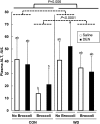Dietary Broccoli Lessens Development of Fatty Liver and Liver Cancer in Mice Given Diethylnitrosamine and Fed a Western or Control Diet
- PMID: 26865652
- PMCID: PMC4763488
- DOI: 10.3945/jn.115.228148
Dietary Broccoli Lessens Development of Fatty Liver and Liver Cancer in Mice Given Diethylnitrosamine and Fed a Western or Control Diet
Abstract
Background: The high-fat and high-sugar Westernized diet that is popular worldwide is associated with increased body fat accumulation, which has been related to the development of nonalcoholic fatty liver disease (NAFLD). Without treatment, NAFLD may progress to hepatocellular carcinoma (HCC), a cancer with a high mortality rate. The consumption of broccoli in the United States has greatly increased in the last 2 decades. Epidemiologic studies show that incorporating brassica vegetables into the daily diet lowers the risk of several cancers, although, to our knowledge, this is the first study to evaluate HCC prevention through dietary broccoli.
Objective: We aimed to determine the impact of dietary broccoli on hepatic lipid metabolism and the progression of NAFLD to HCC. Our hypothesis was that broccoli decreases both hepatic lipidosis and the development of HCC in a mouse model of Western diet-enhanced liver cancer.
Methods: Adult 5-wk-old male B6C3F1 mice received a control diet (AIN-93M) or a Western diet (high in lard and sucrose, 19% and 31%, wt:wt, respectively), with or without freeze-dried broccoli (10%, wt:wt). Starting the following week, mice were treated once per week with diethylnitrosamine (DEN; 45 mg/kg body weight intraperitoneally at ages 6, 7, 8, 10, 11, and 12 wk). Hepatic gene expression, lipidosis, and tumor outcomes were analyzed 6 mo later, when mice were 9 mo old.
Results: Mice receiving broccoli exhibited lower hepatic triglycerides (P < 0.001) and NAFLD scores (P < 0.0001), decreased plasma alanine aminotransferase (P < 0.0001), suppressed activation of hepatic CD68(+) macrophages (P < 0.0001), and slowed initiation and progression of hepatic neoplasm. Hepatic Cd36 was downregulated by broccoli feeding (P = 0.006), whereas microsomal triglyceride transfer protein was upregulated (P = 0.045), supporting the finding that dietary broccoli decreased hepatic triglycerides.
Conclusion: Long-term consumption of whole broccoli countered both NAFLD development enhanced by a Western diet and hepatic tumorigenesis induced by DEN in male B6C3F1 mice.
Keywords: NAFLD; Western diet; broccoli; diethylnitrosamine; liver cancer.
© 2016 American Society for Nutrition.
Conflict of interest statement
Author disclosures: Y-J Chen, MA Wallig, and EH Jeffery, no conflicts of interest.
Figures



Similar articles
-
Dietary broccoli protects against fatty liver development but not against progression of liver cancer in mice pretreated with diethylnitrosamine.J Funct Foods. 2016 Jun;24:57-62. doi: 10.1016/j.jff.2016.03.028. Epub 2016 Apr 12. J Funct Foods. 2016. PMID: 27672403 Free PMC article.
-
Cholic acid supplementation accelerates the progression of nonalcoholic fatty liver disease to the procarcinogenic state in mice fed a high-fat and high-cholesterol diet.J Nutr Biochem. 2022 Feb;100:108869. doi: 10.1016/j.jnutbio.2021.108869. Epub 2021 Sep 24. J Nutr Biochem. 2022. PMID: 34563665
-
The Adenosine Monophosphate (AMP) Analog, 5-Aminoimidazole-4-Carboxamide Ribonucleotide (AICAR) Inhibits Hepatosteatosis and Liver Tumorigenesis in a High-Fat Diet Murine Model Treated with Diethylnitrosamine (DEN).Med Sci Monit. 2018 Nov 26;24:8533-8543. doi: 10.12659/MSM.910544. Med Sci Monit. 2018. PMID: 30474622 Free PMC article.
-
Diethylnitrosamine-induced liver tumorigenesis in mice.Methods Cell Biol. 2021;163:137-152. doi: 10.1016/bs.mcb.2020.08.006. Epub 2020 Oct 2. Methods Cell Biol. 2021. PMID: 33785162 Review.
-
Potential for dietary ω-3 fatty acids to prevent nonalcoholic fatty liver disease and reduce the risk of primary liver cancer.Adv Nutr. 2015 Nov 13;6(6):694-702. doi: 10.3945/an.115.009423. Print 2015 Nov. Adv Nutr. 2015. PMID: 26567194 Free PMC article. Review.
Cited by
-
BMI Is Associated With Increased Plasma and Urine Appearance of Glucosinolate Metabolites After Consumption of Cooked Broccoli.Front Nutr. 2020 Sep 24;7:575092. doi: 10.3389/fnut.2020.575092. eCollection 2020. Front Nutr. 2020. PMID: 33072799 Free PMC article.
-
Protective effects of sulforaphane and aerobic exercise on acute alcoholic hepatic injury in mice.Saudi J Biol Sci. 2020 Nov;27(11):3145-3149. doi: 10.1016/j.sjbs.2020.07.014. Epub 2020 Jul 14. Saudi J Biol Sci. 2020. PMID: 33100876 Free PMC article.
-
Antioxidant dietary approach in treatment of fatty liver: New insights and updates.World J Gastroenterol. 2017 Jun 21;23(23):4146-4157. doi: 10.3748/wjg.v23.i23.4146. World J Gastroenterol. 2017. PMID: 28694655 Free PMC article. Review.
-
Biomarkers of Broccoli Consumption: Implications for Glutathione Metabolism and Liver Health.Nutrients. 2020 Aug 20;12(9):2514. doi: 10.3390/nu12092514. Nutrients. 2020. PMID: 32825248 Free PMC article.
-
Methyl Jasmonate Treatment of Broccoli Enhanced Glucosinolate Concentration, Which Was Retained after Boiling, Steaming, or Microwaving.Foods. 2020 Jun 8;9(6):758. doi: 10.3390/foods9060758. Foods. 2020. PMID: 32521670 Free PMC article.
References
-
- Williams CD, Stengel J, Asike MI, Torres DM, Shaw J, Contreras M, Landt CL, Harrison SA. Prevalence of nonalcoholic fatty liver disease and nonalcoholic steatohepatitis among a largely middle-aged population utilizing ultrasound and liver biopsy: a prospective study. Gastroenterology 2011;140:124–31. - PubMed
-
- World Health Organization. Liver cancer: estimated incidence, mortality and prevalence worldwide in 2012 [Internet]. [cited 2015 Jul 6]. Available from: http://globocan.iarc.fr/Pages/fact_sheets_cancer.aspx.
-
- American Cancer Society. Cancer facts and figures 2015 [Internet]. Atlanta, GA: American Cancer Society, 2015 [cited 2015 Jun 3]. Available from: http://www.cancer.org/acs/groups/content/@ editorial/documents/document/....
-
- Laursen L. A preventable cancer. Nature 2014;516:S2–3. - PubMed
Publication types
MeSH terms
Substances
Grants and funding
LinkOut - more resources
Full Text Sources
Other Literature Sources
Medical

